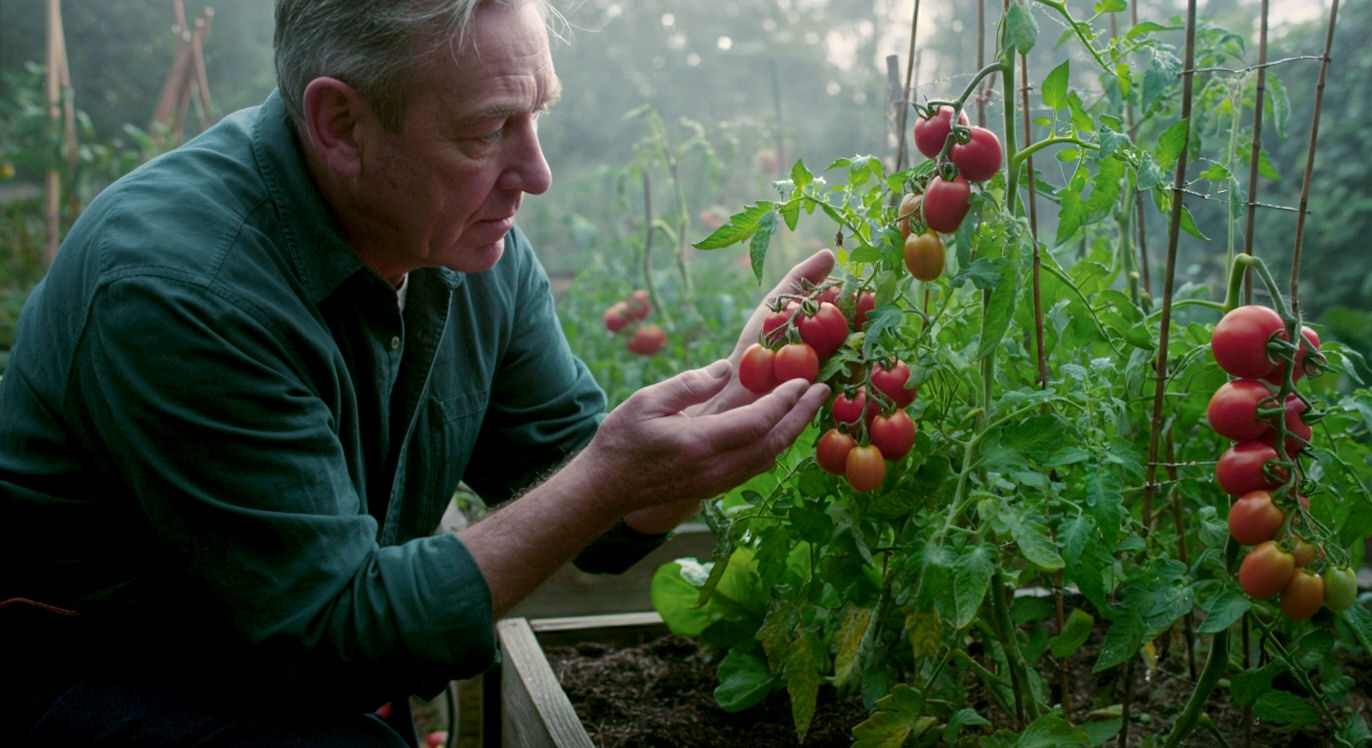Organic Disease Control: The Guide to a Thriving, Resilient British Garden
The ultimate guide to organic disease control for British gardeners. Learn to build healthy soil, choose resistant varieties, and create a thriving, resilient garden.

This post may contain affiliate links. If you make a purchase through these links, we may earn a commission at no additional cost to you.
If you’ve ever walked out to your garden or allotment on a damp August morning to find your prized tomato plants collapsing under a fuzzy, brown-spotted attack, you know the feeling. It’s a gut punch. All that hard work—sowing seeds on the windowsill back in March, potting on, hardening off, planting out—seems to have been for nothing. The enemy, in this case, is likely blight, and our first instinct, drilled into us for decades, is to reach for a chemical spray. We’ve been taught to see gardening as a battle: us versus the pests and diseases.
But what if that’s the wrong way to look at it?
What if, instead of fighting a constant war, we could create a garden that largely looks after itself? A garden so healthy, so balanced, and so resilient that diseases struggle to get a foothold in the first place. This is the heart of organic disease control. It’s not about finding a magic organic spray to replace a chemical one; it’s a complete shift in thinking. It’s about becoming less of a ‘plant doctor’ who only treats symptoms, and more of a ‘garden ecosystem builder’ who fosters brilliant health from the ground up.
This guide will walk you through everything you need to know to build that thriving, resilient British garden. We’ll get our hands dirty in the soil, recruit an army of tiny allies, and learn the simple, clever habits that can transform your plot. Forget the endless battle. It’s time to work with nature, not against it.
The Soil is Everything: The Foundation of Plant Health
Let’s start with a simple but profound idea: your soil is your plant’s gut. Just as a healthy gut is the cornerstone of human health, a living, breathing, vibrant soil is the absolute foundation of a healthy garden. If you get the soil right, you’re more than halfway to beating disease.
Plants don’t just suck up water and nutrients from the soil like a straw. They are part of a bustling, microscopic community known as the soil food web. This underground world is teeming with life: billions of bacteria, fungi, protozoa, nematodes, worms, and other tiny creatures. In a healthy soil, this community works together. They break down organic matter (like old leaves and roots) into nutrients that plants can absorb. They create a crumbly, open structure that allows air and water to penetrate. And, crucially, they defend their home—and your plants’ roots—from the nasty pathogens that cause disease.
When we spray chemicals, dig excessively, or leave the soil bare, we damage this delicate web of life. The good guys are killed off or disrupted, which rolls out the welcome mat for the bad guys.
Getting Your Hands Dirty: How to Build Superb Soil
Building fantastic soil isn’t complicated. It boils down to one simple rule: feed the soil, and the soil will feed your plants. Here’s how you do it.
Composting: The Gardener’s Black Gold
If you do only one thing for your soil, make compost. It’s the single best thing you can add to your garden. Good compost is packed with a diverse range of beneficial microbes, slow-release nutrients, and organic matter that improves soil structure.
Making it is easy. You just need a mix of ‘greens’ and ‘browns’:
- Greens (Nitrogen-rich): These are wet, fresh materials like grass clippings, vegetable peelings, coffee grounds, and young weeds (before they set seed!).
- Browns (Carbon-rich): These are dry, woody materials like cardboard, scrunched-up paper, straw, dead leaves (leaf mould), and small twigs.
The trick is to layer them. A good rule of thumb is to aim for roughly two parts brown material to one part green. Keep the heap moist, but not soggy—like a wrung-out sponge. Turn it with a fork every month or two if you can, and in anything from a few months to a year, you’ll have dark, crumbly, sweet-smelling compost ready to spread on your garden beds.
Mulching: A Blanket for Your Soil
Mulching is simply covering the surface of your soil with a layer of organic material. Think of it as a protective blanket. A good mulch will:
- Suppress weeds: It blocks light, stopping weed seeds from germinating.
- Conserve moisture: It reduces evaporation from the soil surface, meaning you need to water less often.
- Feed the soil: As the mulch slowly breaks down, earthworms and other creatures will pull it down into the soil, feeding that all-important soil food web.
Great mulching materials in the UK include your homemade compost, well-rotted manure, leaf mould (rotted leaves), wood chippings (best for paths or around hardy shrubs and trees), or straw. Simply spread a layer, a few inches thick, on the soil surface around your plants.
No-Dig Gardening: Let Nature Do the Work
For centuries, we’ve been told to dig our gardens every autumn. But a growing movement, popularised in the UK by gardeners like Charles Dowding, champions a ‘no-dig’ approach. The logic is simple: digging breaks up the delicate networks of fungal hyphae, disturbs worm burrows, and destroys the soil’s natural structure. It’s like smashing up the city that your soil microbes live in.
With no-dig, you simply add a thick layer of compost or other mulch on top of the soil once or twice a year. The worms and microbes do the ‘digging’ for you, incorporating the goodness into the soil below. Plants can be planted directly into this compost layer. The result is healthier soil, far fewer weeds, and stronger, more resilient plants.
Green Manures: Planting for Your Soil
A green manure is a crop you grow specifically to improve the soil, not to eat. You sow the seeds, let them grow for a few weeks or months, and then chop them down before they produce flowers or seeds, leaving the foliage on the surface to rot down as a mulch. Some types, like winter tares or grazing rye, are brilliant for covering bare soil over the winter.
They protect the soil from being washed away by winter rains, prevent weeds from taking over, and their roots help to keep the soil structure open. Legumes, like clover or field beans, have an extra trick: they can take nitrogen from the air and ‘fix’ it in the soil, providing a free, natural fertiliser for the crop that follows.
Clever Gardening: Outsmarting Diseases Before They Start
Once you have a foundation of healthy soil, the next step is to adopt some smart gardening habits. These are known as ‘cultural controls’, and they’re all about creating an environment where diseases find it hard to thrive. It’s simple, preventative medicine for your garden.
Choose Your Fighters: Picking Disease-Resistant Varieties
Plant breeding has come a long way. These days, you can buy seeds and plants that have natural, bred-in resistance to common diseases. This doesn’t always mean they’ll never get the disease, but it gives them a massive head start and a much better chance of shrugging it off.
When you’re browsing a seed catalogue or a garden centre, look for descriptions that mention disease resistance. For example:
- Potatoes: Varieties like the ‘Sarpo’ range (‘Sarpo Mira’, ‘Sarpo Axona’) are famous for their incredible blight resistance.
- Tomatoes: Many modern varieties are advertised as ‘blight-resistant’. ‘Crimson Crush’ and ‘Mountain Magic’ are two popular choices that perform well in the UK.
- Roses: If you’re tired of black spot, look for roses that have received the Royal Horticultural Society (RHS) Award of Garden Merit (AGM). This is a good sign that they are strong, reliable growers with good disease resistance in UK conditions.
Choosing the right plant for the right spot also makes a huge difference. A sun-loving plant grown in the shade will be weak and stressed, making it a prime target for disease.
Give Them Some Space: The Importance of Good Airflow
Fungal diseases, like powdery mildew, blight, and many rusts, absolutely love damp, still conditions. Their spores land on a wet leaf and, if the leaf stays wet for a few hours, they can germinate and infect the plant.
The easiest way to fight this is to improve air circulation around your plants.
- Space them out: Don’t cram your plants together. Read the spacing recommendations on the seed packet. It might look a bit sparse at first, but they will soon fill out. Good spacing allows air to move freely between them, drying the leaves quickly after rain or morning dew.
- Prune for airflow: For plants like tomatoes, removing the lower leaves as the plant grows allows more air to circulate around the base. For fruit trees like apples and plums, winter pruning to create an open, goblet shape is essential for preventing fungal problems like canker and brown rot.
Crop Rotation: Don’t Let Diseases Get Comfy
Many plant diseases are soil-borne, and they are often specific to a particular family of plants. For example, the fungus that causes clubroot only affects brassicas (cabbages, broccoli, kale, etc.), while potato blight pathogens can linger in the soil to infect next year’s spuds.
Crop rotation is the simple practice of not growing the same family of plants in the same patch of ground year after year. This prevents diseases from building up in the soil to damaging levels. A simple four-year rotation for an allotment or veg patch could look like this:
- Year 1: Potatoes and Tomatoes (Solanaceae family)
- Year 2: Cabbages, Kale, Broccoli (Brassica family)
- Year 3: Peas and Beans (Legume family)
- Year 4: Onions, Leeks, and Root Veg (like carrots and parsnips)
Then, in Year 5, you go back to potatoes in the first bed. It’s like a game of musical chairs for your veg, ensuring the pathogens never get a chance to build a permanent home.
Watering Wisely: The Right Way, at the Right Time
How and when you water can make a huge difference. The golden rule is to water the soil, not the leaves. Splashing water all over the foliage creates the perfect damp conditions for fungal spores to thrive. Use a watering can with a rose, and direct the water at the base of the plant.
The best time to water is in the morning. This gives the plant all day to use the water, and any moisture that does get on the leaves has plenty of time to dry off in the sun before the cool of the evening sets in. Watering at night can mean the leaves stay wet for hours, which is an open invitation for mildew and blight.
Garden Hygiene: The Tidy Gardener’s Secret Weapon
Good hygiene is a simple but effective way to stop diseases from spreading.
- Remove diseased material: As soon as you spot a diseased leaf—one with black spot, mildew, or rust—snip it off and get it out of the garden. Crucially, do not put diseased material on your compost heap. Many pathogens can survive the composting process and will just be spread back over your garden later. Burn it or put it in your green waste bin.
- Clear up in autumn: At the end of the season, clear away old, dying plant material, especially from things like tomatoes, potatoes, and courgettes. This removes the places where fungal spores can hide over winter.
- Clean your tools: When you’re pruning, especially on roses or fruit trees, it’s good practice to clean your secateurs between plants. This stops you from accidentally transferring microscopic spores from a sick plant to a healthy one. A quick wipe with a cloth soaked in disinfectant or rubbing alcohol is all it takes.
Recruiting an Army: Using Nature’s Helpers
Your garden is not a sterile environment. It’s a habitat, and you can invite in allies that will help you keep diseases and pests in check. This is the fun part—it’s where you actively become an ecosystem builder.
Good Bugs vs. Bad Bugs: Attracting Beneficial Insects
Many pests, like aphids (greenfly), weaken plants by sucking their sap. This stress makes the plants more vulnerable to disease. Furthermore, some pests can even act as tiny taxis, physically spreading viral and fungal diseases from one plant to another.
The organic solution isn’t to spray the aphids, but to encourage their natural predators. A healthy British garden should be buzzing with beneficial insects that will do the pest control for you, for free. Your top recruits include:
- Ladybirds: Both the adults and their slightly terrifying, crocodile-like larvae are brilliant at munching through aphids.
- Hoverflies: Their larvae are also voracious aphid eaters.
- Lacewings: Often called ‘aphid lions’, their larvae have a huge appetite for pests.
- Spiders and Beetles: These ground-based predators hoover up slugs and other pests.
To attract these helpers, you need to provide them with food (other than pests) and shelter. The best way is to plant a wide variety of flowers. Insects are particularly attracted to flowers with open, easily accessible nectar, like those in the daisy and carrot families. Try planting strips of marigolds, poached egg plant (Limnanthes), phacelia, dill, fennel, and yarrow amongst your vegetables. And a ‘bug hotel’, made from hollow stems, logs, and pinecones, provides a safe place for them to shelter and hibernate over winter.
The Magic of Microbes: Beneficial Fungi and Bacteria
The world of beneficial microbes is fascinating, and we’re only just beginning to understand its importance in the garden.
Mycorrhizal Fungi: The Underground Internet
Mycorrhizal fungi are incredible organisms that form a symbiotic relationship with the roots of most plants. The fungi act like a vast extension of the plant’s own root system, creating a super-fine network that can stretch for metres, seeking out water and nutrients (especially phosphorus) that the plant couldn’t reach on its own. In return, the plant gives the fungi some of the sugars it produces through photosynthesis.
This partnership makes for a much stronger, healthier, and more resilient plant that is far better equipped to deal with stress from drought or disease. You can buy mycorrhizal fungi as granules or a powder to add to the planting hole when you’re putting in new plants, especially long-lived ones like shrubs, trees, and roses.
Compost Tea: A Probiotic Drink for Your Plants
Just like you might drink a probiotic yogurt for your gut health, you can give your plants a probiotic boost with compost tea. This isn’t just the brown liquid that leaks from your compost bin (that’s ‘leachate’). Proper compost tea is made by actively brewing good-quality compost in aerated water for 24 hours.
The brewing process causes the beneficial bacteria, fungi, and protozoa in the compost to multiply by the millions. When you spray this liquid onto your plants’ leaves, you’re colonising the leaf surface with an army of good microbes. They take up all the space and resources, effectively crowding out and out-competing any disease pathogens that might be trying to get established. It’s a fantastic preventative treatment, particularly for things like mildew and black spot.
Your Organic Toolkit: Natural Sprays and Treatments
Even in the most resilient garden, you will sometimes need to intervene. When problems do arise, there are several simple, homemade, and effective sprays you can use that won’t harm the wider environment.
Tackling Fungal Foes: Mildew, Blight, and Rust
Most of the common diseases in British gardens are fungal. Here are a few simple recipes to have in your toolkit.
- Milk Spray for Powdery Mildew: This sounds like an old wives’ tale, but it really works, and scientists think it’s because proteins in the milk react with sunlight to create an antiseptic effect. It’s most effective on powdery mildew, which often plagues courgettes, pumpkins, and some roses.
- Recipe: Mix one part milk (any kind, even powdered) with about nine parts water.
- Application: Spray onto affected leaves in bright, sunny weather for the best effect. Re-apply weekly or after rain.
- Baking Soda (Bicarbonate of Soda) Spray: Bicarb creates a slightly alkaline environment on the leaf surface, which makes it difficult for fungal spores to germinate.
- Recipe: Mix one teaspoon of bicarbonate of soda with one litre of water. Add a few drops of washing-up liquid to help it stick to the leaves.
- Application: Shake well and spray on plants prone to fungal diseases as a preventative measure. Be careful not to make it too strong, as it can scorch leaves.
- Comfrey or Nettle ‘Tea’: These aren’t fungicides, but rather powerful plant tonics. Comfrey is rich in potassium, which is great for fruit and flower development, while nettles are full of nitrogen and minerals. A strong, well-fed plant is a resilient plant.
- How to make it: Find a bucket with a lid. Stuff it full of comfrey or nettle leaves (wear gloves for the nettles!). Top up with water, put the lid on, and leave it for a few weeks. It will stink to high heaven, but the resulting dark liquid is liquid gold.
- Application: Dilute the dark liquid with water until it’s the colour of weak tea, and use it as a liquid feed for your plants every couple of weeks.
A Quick-Fire Guide to Common UK Garden Diseases
Knowing your enemy is half the battle. Here’s how to spot and deal with some of the most common culprits in British gardens.
- Potato and Tomato Blight:
- Symptoms: Rapidly spreading brown-black spots and patches on leaves, often with a pale, fuzzy edge on the underside. Stems will develop dark patches and the whole plant can collapse quickly in damp weather.
- Action Plan: Prevention is key. Use resistant varieties and ensure good airflow. At the first sign, remove and destroy affected leaves immediately. If it takes hold, it’s often best to cut your losses, remove the entire plant, and get it out of the garden to save others. Never compost blighted material.
- Rose Black Spot:
- Symptoms: Dark purple-black spots on the leaves, which are often surrounded by a yellow halo. Affected leaves will eventually fall off, weakening the plant.
- Action Plan: Choose resistant varieties. Gather and destroy all fallen leaves, as the spores overwinter on them. Mulch the ground beneath the rose heavily in spring to stop spores from splashing back up onto new leaves. Prune for good airflow.
- Powdery Mildew:
- Symptoms: A distinctive white, dusty, powdery coating on leaves, stems, and buds. Common on courgettes, cucumbers, peas, and some roses, especially when the soil is dry but the air is humid.
- Action Plan: Improve air circulation. Water the soil regularly to avoid drought stress. Remove the worst affected leaves and try the milk spray trick.
- Rust:
- Symptoms: Small, raised orange, brown, or yellow spots and pustules, usually on the underside of leaves. Common on hollyhocks, leeks, garlic, and beans.
- Action Plan: This is another one that thrives in damp conditions. Avoid watering the leaves. Remove and destroy infected leaves as soon as you see them to stop the cycle. Ensure good airflow.
The Gardener’s Best Tool: Your Eyes
This might be the most important piece of advice in the whole guide. The most effective tool you have for organic disease control is you. Specifically, your attention.
Make a habit of walking around your garden for five minutes every day. Don’t just look at the whole picture; get up close. Look under leaves. Check the stems. See what’s buzzing around. By observing your garden regularly, you’ll start to notice the first, tiny signs of trouble. You’ll spot the first mildewed leaf or the first evidence of blight long before it becomes a major outbreak.
Catching problems early is the absolute key to success with organic methods. It allows you to simply snip off one or two affected leaves, rather than having to deal with a full-blown epidemic later on.
Conclusion: Your Garden as a Thriving Ecosystem
Moving to an organic approach to disease control is a journey. It requires a fundamental shift in mindset—from seeing your garden as a collection of individual plants to be protected, to seeing it as a single, interconnected ecosystem to be nurtured.
It begins underground, with a soil that is alive and packed with beneficial microbes. It continues with clever choices—resistant varieties, good spacing, and smart watering. It involves inviting in nature’s own pest-control patrol and brewing tonics to boost your plants’ own immune systems.
By focusing on these principles, you are doing more than just preventing disease. You are building a garden that is robust, self-sufficient, and humming with life. You’re not just a gardener anymore; you’re the custodian of your own little ecosystem. And the reward is not just healthier plants and more delicious homegrown food, but a deeper connection to the natural world right outside your back door.
Further Reading & Resources
For those looking to dive even deeper, these British-based organisations are fantastic sources of information and inspiration:
- Garden Organic: The UK’s national charity for organic growing. Their website is a treasure trove of practical, expert advice.
- The Royal Horticultural Society (RHS): A world-leading gardening charity, offering reliable and scientific advice on all aspects of gardening, including organic methods and pest/disease identification.
- Charles Dowding’s Website: A brilliant resource for anyone interested in the no-dig gardening method, with decades of experience and results to share.






